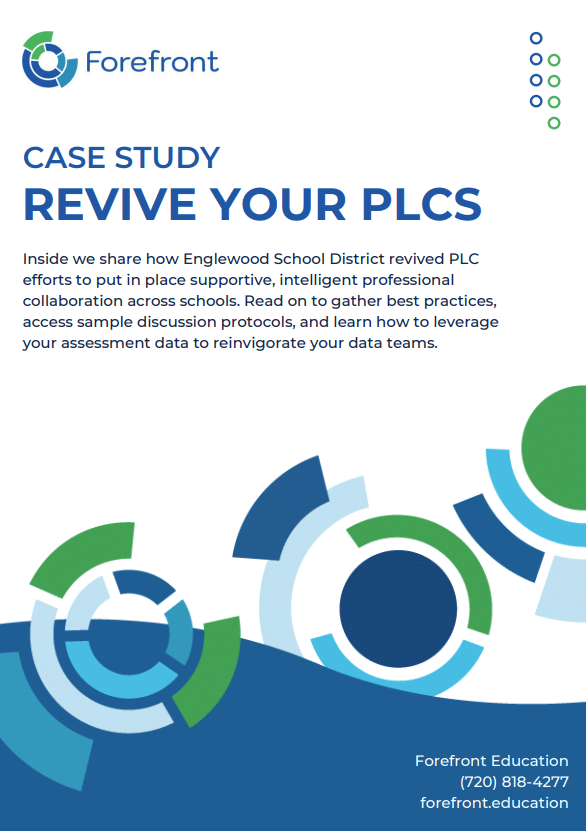Literacy Assessments for Instructional Coaching
- February 1, 2024
- Blog

Instructional coaching is a powerful and widely accepted tool for helping teachers improve their craft. Effective instructional coaches use a variety of strategies to support their teachers, including observation and feedback, modeling, collaborative planning, co-teaching, and data analysis. At the core of this work, it is essential that data, including literacy assessments, plays a central role in driving instruction and informing decisions (Marsh, 2010).
There is no shortage of opportunities for assessment in schools today. This is especially true for our English Language Arts classrooms, where a variety of tools and methods are often used to evaluate various aspects of language proficiency. As a literacy coach, it is important to not only help select and use the right assessments, but also to support teachers in leveraging their results to inform planning and improve instruction. It is not enough to collect data; data must be meaningful, well managed, and put into action to inform instruction and improve student outcomes.
Here are five key steps for effectively using literacy assessments for instructional coaching:
Plan and Prioritize
Guiding Questions:
-
- What do students need to know by the end of the year?
- How and when will students be assessed on these learning targets?
Start with What You Know
Begin by identifying the common literacy assessments required of your students during the year. These are often selected by your school or district and include state assessments, school or district wide benchmarks, and any other common assessments you know students must take on a given date. Next, consider the core instructional program or programs you are using for this content. Identify the major unit tests and end-of-module assessments students will take, and when they will be assessed. Collaborate with teachers to ensure the learning objectives of assessments are clear, as well as how the assessments align to the learning goals of the year. These assessments, once defined, provide guideposts for long term planning, and their learning objectives offer a roadmap for teachers to reference throughout the year.
Backwards Planning
Once teams understand end-of-year expectations, support teachers in finding alignment between assessments. Ask: “Where in my core instructional program are standards on my next district benchmark assessed?” Use this framework to backwards plan for instruction so that lessons with the highest leverage learning targets are identified early and executed with intention to their alignment.
For example, by the end of second grade, students should be able to describe how characters in a story respond to major events; while planning, you identify several questions aligned to this learning target on their MOY District Benchmark. Identify those lessons in your core instructional program that teach this skill and offer opportunities for practice. Plan to check in with teachers about this assessment data so that support can be provided prior to the district benchmark. When this work happens in advance of instruction, the data becomes more meaningful and, as a result, more actionable.
Conduct Universal Screenings Early – And Use the Data
Guiding Questions:
-
- How do we plan to use this data? Does the screener we selected align to this goal?
- When are we providing protected time to analyze data and plan for intervention?
Administer validated, evidence-based screeners to all students at the start of the year to identify students at risk for reading difficulties. Screeners like DIBELS and AIMSweb provide baseline data on foundational skills. It is important to be intentional about the universal screeners administered, and to ensure that data on literacy skills expected at each grade level is collected. For example, in kindergarten and first grade, early skills like letter sound knowledge, phonemic awareness, alphabetic decoding, and oral reading fluency are prioritized. For upper grades, screeners emphasize reading fluency, vocabulary, and reading comprehension. Align screeners to grade level literacy standards and student expectations. Use the same screener for all students within each grade level for consistency. Carefully follow the test administration procedures to get reliable results. Reassess at intervals recommended by the program to evaluate student growth and make adjustments to instruction.
Leverage Your Data
Collecting the data is only the first step; too often, we celebrate completing the process of screening students before we plan to use the results. As with any assessment administered, the data will only add value if it is analyzed for meaning and planned into action. Identify those students who score below benchmark on foundational reading skills and plan for intervention. In addition to identifying students in need of support, use this data as a baseline for all students with which to measure growth, leverage strengths, and inform decisions about instructional priorities for the year. Allow results to shape student groups for targeted instruction early so that resources can be identified and allocated where they are needed most. Consider options for professional development that support teachers in instructional areas of highest need.
Need help gathering and making sense of literacy data? Check out a quick, video overview of our assessment data solution here.
Progress Monitor and Track
Guiding Questions:
-
- Are students making progress towards their goals?
- Which instructional strategies are most effective?
After identifying at-risk students and setting up interventions, administer progress monitoring assessments to track growth and make timely adjustments. The purpose of progress monitoring assessments is to quickly identify whether or not students are making progress towards established, grade-level benchmarks and are on track to catch up with their peers. It is important that progress monitoring assessments are skill based, and offer reliable predictors of success relevant to each skill. For example, the skill of decoding is a foundational skill that is necessary for reading fluency and comprehension; decoding, then, is a reliable predictor of success for reading comprehension because students who struggle to decode will likely struggle to comprehend while students who are strong decoders tend to be better readers over all (Archer, 2003).
Support teachers in administering progress monitoring assessments weekly or every other week to students receiving intensive intervention. It may be necessary to provide training on how to administer and score progress monitoring assessments efficiently. Offer guidance on selecting assessments that are appropriate for different grade levels and include skills that can help teachers make informed decisions. Once progress monitoring data is collected, provide support in analyzing the results and using them to guide instruction. Providing resources such as data analysis templates or protected PLC time where teachers can collaborate and share best practices can be helpful.
Set Goals Based on Student Data and Plan for Support
Guiding Questions:
-
- What data will inform literacy goals for students? For teachers and leaders?
- How will we build investment and excitement around goals?
Goal setting is essential for both teachers and students in driving literacy instruction. Research confirms what teachers and leaders in the classroom already know: students are struggling academically in every subject.
According to the National Center for Education Statistics, in 2019, nearly one-third of fourth-grade students were not reading at grade level (NCES, 2021). Also true is that students who struggle with reading in early elementary are at a higher risk for academic difficulties later on and are less likely to graduate high school. Students who are not proficient in reading by the end of third grade are four times more likely to drop out of high school than than their peers who read on grade level (Lesnick, 2010).
It is important to remember the why behind the work. Engage teachers and students in this dialogue as well. Goal-setting conversations provide an excellent opportunity to invest students in their goals. These conversations also make the data meaningful within a larger context for everyone.
Use data provided by early assessments and, when available, common assessments from the previous year, to set individual goals for students. Students should have both long term and short term goals they are working towards. They should also know when they are expected to reach each goal. Make sure students understand what their goal means and what they have to do in order to reach it. Setting individualized, data-informed goals promotes a growth mindset within the classroom. While it is still important to consider whether grade-level objectives are met, focusing only on questions like “did I pass or fail” limits students’ opportunity to experience success.
Collaborate and Coach
Guiding Questions:
-
- Where does the data show my students and teachers need the most support?
- What support is most useful for my teacher? For our students?
Instructional coaching is most effective when a partnership exists between coaches and teachers. When coaches value teachers’ voices, they are more receptive to feedback and willing to make changes to their instructional practices. Student success is the end goal. While the role teachers and leaders play may be different, both share in the responsibility to reach this goal. It is important to frame data-conversations with teachers as opportunities for growth, and to celebrate successes wherever they are present.
Once teams identify areas of need, collaborate with teachers to identify the root cause. Determine the support needed to best support both teachers and students. Support may look like professional development opportunities so that teachers can learn strategies to improve oral reading fluency. It may be helpful to model an effective instructional practice or co-teach on a high leverage learning objective. Teachers may need support in differentiating their instruction based on the range of data collected. Ensure the support provided is responsive to both the data collected and the needs of the teacher.
Following these steps will ensure you use literacy assessments effectively to understand student needs, monitor progress, and guide your coaching.
Works Cited
Archer, Anita L. et al. “Decoding and Fluency: Foundation Skills for Struggling Older Readers.” Learning Disability Quarterly 26 (2003): 101 – 89.
Lesnick, Joy K et al. “Reading on Grade Level in Third Grade: How Is It Related to High School Performance and College Enrollment? A Longitudinal Analysis of Third-Grade Students in Chicago in 1996-97 and Their Educational Outcomes. A Report to the Annie E. Casey Foundation.” (2010).
Marsh, Julie A. et al. “How Instructional Coaches Support Data-Driven Decision Making.” Educational Policy 24 (2010): 872 – 907.
National Center for Education Statistics. (2021). The Nation’s Report Card: 2019 Reading Assessment (NCES 2021-144). U.S. Department of Education, Institute of Education Sciences, National Center for Education Statistics. Retrieved from https://nces.ed.gov/pubs2021/2021144.pdf
Yilmazer, Meryem Özdemir and Yonca Özkan. “Classroom assessment practices of English language instructors.” Journal of Language and Linguistic Studies 13 (2017): 324-345.
About us and this blog
Our team and tools help schools implement standards-based grading, streamline assessment systems, and use meaningful data to drive decision-making.
Free PLC Case Study
Learn about how Forefront client Englewood School District put in place supportive, intelligent professional collaboration across schools. Download your free copy today to access best practices, view sample discussion protocols, and learn how to leverage your assessment data to reinvigorate your data teams.

More from our blog
See all postsForefront is the only assessment data solution optimized for classroom assessment results, leveraging these results to fuel instruction, PLCs, and grading. Elevate meaningful assessment data district-wide to transform how you understand and communicate about student learning across your schools.
Copyright © 2025 Forefront Education, Inc. All Rights Reserved.







